Didea intermedia Loew, 1854
Identification
Identification difficulty = 4. ![]()
![]() according to Ball & Morris, 20241
according to Ball & Morris, 20241
Biology
The larva is strongly associated with Pinus. Adults are almost always associated with coniferous forest, including conifers planted on sand dunes. A few records from deciduous woodland in southern Britain are suspect, and may well be misidentifications of D. fasciata. Adults are flower visitors and can be found at yellow composites. In Scottish pinewoods they can often be found visiting White Bedstraw Galium saxatile, sometimes in considerable numbers.
Flight period
The following plots show the number of unique records per week excluding those reported to be of immature stages.

Status
Lower Risk (Nationally scarce) - Ball & Morris, 20142. Notable - Falk, 19913.
Distribution
A northern species, with most records from Scotland and north-west England. It occurs on coniferised heathland on the Surrey/Hampshire border, and on the heathlands of Dorset and Hampshire.

Trends
The following plots show the Frescalo TFactor vs year and a map of the rescaled frequency (all records) for the species.
-
Ball, S., & Morris, R. (2024). Hoverflies of Britain and Ireland. WILDGuides (3rd ed.). Oxford: Princeton University Press. ↩
-
Ball, S., & Morris, R. (2014). A review of the scarce and threatened flies of Great Britain. Part 6: Syrphidae. ( No. 9). Species status (pp. 1–130). Peterborough: JNCC. ↩
-
Falk, S. (1991). A review of the scarce and threatened flies of Great Britain. ( No. 39). Research and Survey in Nature Conservation (pp. 1–194). Peterborough: NCC. ↩